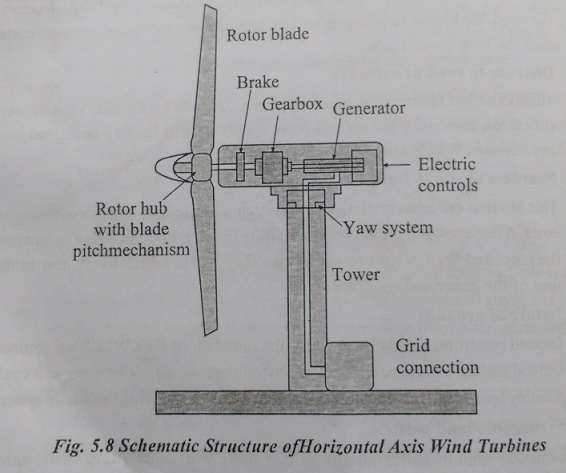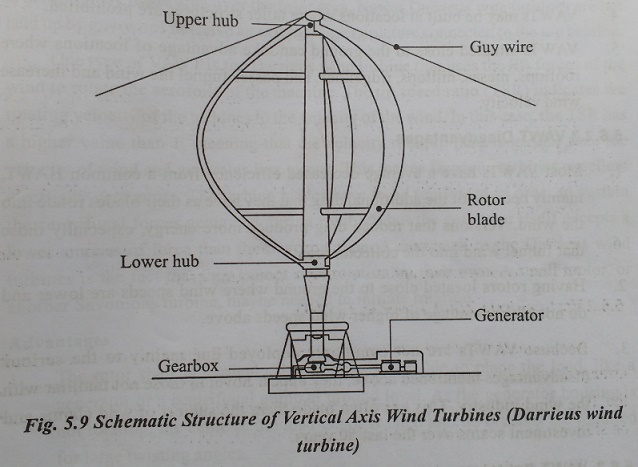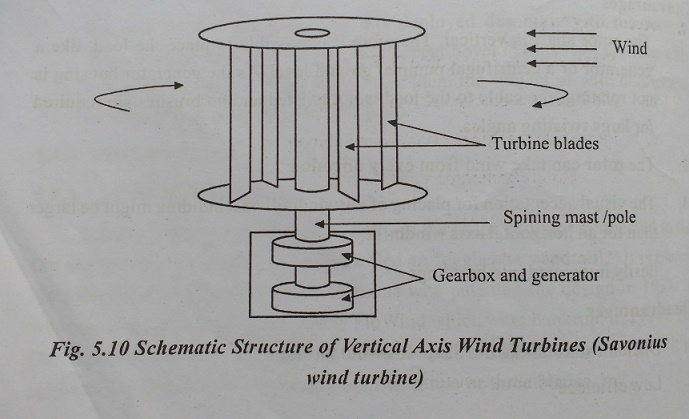Chapter: Electric Energy Generation and Utilisation and Conservation : Wind Energy
Types of Wind Turbines
TYPES OF WIND TURBINES
Wind turbines can be separated into two basic types determined by which way the turbine spins. Wind turbines that rotate around a horizontal axis are more common (like a wind mill), while vertical axis wind turbines are less frequently used (Savonius and Darrieus are the most common in the group).
1. Horizontal Axis Wind Turbines (HAWT)
Horizontal axis wind turbines, also shortened to HAWT, are the common style that most of us think of a wind turbine. A HAWT has a similar design to a windmill, it has blades that look like a propeller that spin on the horizontal axis as shown in figure.

Horizontal axis wind turbines have the main rotor shaft and electrical generator at the top of a tower, and they must be pointed into the wind. Small turbine are pointed by a simple wind vane placed square with the rotor (blades), while large turbines generally use a wind sensor coupled with a servo motor to turn the turbine into the wind. Most large wind turbines have a gearbox, which turns the slow rotation of the rotor into a faster rotation that is more suitable to drive an electrical generator.
Since a tower produces turbulence behind it, the turbine is usually pointed upwind of the tower. Wind turbine blades are made stiff to prevent the blades from being pushed into the tower by high winds. Additionally, the blades are placed a considerable distance in front of the tower and are sometimes tilted up a small amount.
Downwind machines have been built, despite the problem of turbulence, because they don’t need an additional mechanism for keeping them in line with the wind. Additionally, in high winds the blades can be allowed to bend which reduces their swept area and thus their wind resistance. Since turbulence leads to fatigue failures, and reliability is so important, most HAWTs are upwind machines.
Important point to remember recording HAWT:
(1) Lift is the main force
(2) Much lower cyclic stress
(3) 95% of the existing turbines are HAWTs
(4) Nacelle is placed at the top of the tower
(5) Yaw mechanism is required
HAWT Advantage
1. The tall tower base allows access to stronger wind in sites with wind shear. In some wind shear sites, every ten meters up the wind speed can increase by 20% and the power output by 34%.
2. High efficiency, since the blades always move perpendicular to the wind, receiving power through the whole rotation. In contrast, all vertical axis wind turbines, and most proposed airborne wind turbine designs, involve various types of reciprocating actions, requiring airfoil surfaces to the wind leads to inherently lower efficiency.
HAWT Disadvantages
1. Massive tower construction is required to support the heavy blades, gearbox, and generator.
2. Components of horizontal axis wind turbine (gearbox, rotor shaft and brake assembly) being lifted into position.
3. Their height makes them obtrusively visible across large areas, disrupting the appearance of the landscape and sometimes creating local opposition.
4. Download variants suffer from fatigue and structural failure caused by turbulence when a blade passes through the tower’s wind shadow (for this reason, the majority of HAWTs use an upwind design, with the rotor facing the wind in front of the tower).
5. HAWTs require an additional yaw control mechanism to turn the blades toward the wind.
6. HAWTs generally require a braking or yawing device in high winds to stop the turbine from spinning and destroying or damaging itself.
2. Vertical Axis Wind Turbines(VAWT)
Vertical wind turbines, as shortened to VAWTs, have the main rotor shaft arranged vertically as shown in Fig 5.9. The main advantage of this arrangement is that the wind turbine does not need to be pointed into the wind. This is an advantage on site where the wind direction is highly variable or has turbulent winds.
With a vertical axis, the generator and other primary components can be placed near the ground, so the tower does not need to support it, also makes maintenance easier. The main drawback of a VAWT generally create drag when rotating into the wind.
It is difficult to mount vertical-axis turbines on towers, meaning they are often installed nearer to the base on which they rest, such as the ground or a building rooftop. The wind speed is slower at a lower altitude, so less wind energy is available for a given size turbine. Air flow near the ground and other objects can create turbulent flow, which can introduce issues of vibration, including noise and bearing wear which may increase the maintenance or shorten its service life. However, when a turbine is mounted on a rooftop, the building generally redirects wind over the roof and this can double the wind speed at the turbine. If the height of the rooftop mounted turbine tower is approximately 50% of the building height, this is near the optimum for maximum wind energy and minimum wind turbulence.

Important points to remember recording VAWT:
Nacelle is placed at the bottom.
Drag is the main force
Yaw mechanism is not required
Lower starting torque
Difficulty in mounting the turbine
Unwanted fluctuations in the power output
VAWT Advantages
1. No yaw mechanisms is needed
2. A VAWT can be located nearer the ground, making it easier to maintain the moving parts.
3. VAWTs have lower wind startup speeds than the typical the HAWTs.
4. VAWTs may be built at locations where taller structures are prohibited.
5. VAWTs situated close to the ground can take advantage of locations where rooftops, means hilltops, ridgelines, and passes funnel the wind and increase wind velocity.
VAWT Disadvantage
1. Most VAWTs have a average decreased efficiency from a common HAWT, mainly because o the additional drag that they have as their blades rotate into the wind. Versions that reduce drag produce more energy, especially those that funnel wind into the collector area.
2. Having rotors located close to the ground where wind speeds are lower and do not take advantage of higher wind speeds above.
3. Because VAWTs are not commonly deployed due mainly to the serious disadvantage mentioned above, they appear novel to those not familiar with the wind industry. This has often made them the subject of wild claims and investment scams over the last 50 years.
3. VAMT Subtypes
Darrieus Wind Turbine
Darrieus turbine has long, thin blades in the shape of loops connected to the top and bottom of the axle; it is often called an “eggbeater windmill.” It is named after the French engineer Georges Darrieus who patented the design in 1931. (It was manufactured by the US company FLoWind which went bankrupt in 1997). The Darrieus turbine is characterized by its C-shaped rotor blades which give it its eggbeater appearance. It is normally built with two or three blades.
Darrieus wind turbines are commonly called “Eggbeater” turbines, because they look like a giant eggbeater. They have good efficiency, but produce large torque ripple and cyclic stress on the tower, which contributes to poor reliability. Also, they generally require some external power source, or an additional savonius rotor, to start turning, because the starting torque is very low. The torque ripple is reduced by using three or more blades which results in a higher solidity for the rotor. Solidity is measured by blade area over the rotor area. Newer Darrieus type turbines are not help up by guy-wires but have an external superstructure connected to the top bearing.
One type of VAWT is the Darrieus wind turbine that uses the lift forces of the wind to rotate the aerofoils of the machine. The tip speed ratio (TSR) indicates the rotating velocity of the turbines to the velocity of the wind. In this case, the TSR has a higher value than 1, meaning that the velocity rotation here is greater than the velocity of wind and generates less torque. This makes Darrieus turbines excellent electricity generators. The turbine blades have to be reinforced in order to sustain the centrifugal forces generated during rotation, but the generator itself accepts a lower amount of force than the Savorius type. A drawback to the Darrieus wind turbines is the fact that they cannot start rotation on their own. A small motor, or another Savonius turbine, maybe needed to initiate rotation.
Advantages
(1) The rotor shaft is vertical. Therefore it is possible to place the load, like a generator or a centrifugal pump at ground level. As the generator housing is not rotating, the cable to the load is not twisted and no brushes are requires for large twisting angles.
(2) The rotor can take wind from every direction.
(3) The visual acceptation for placing of the windmill on a building might be larger than for an horizontal axis windmill.
(4) Easily integrates into buildings.
Disadvantages
(1) Difficult start unlike the Savonius wind turbine.
(2) Low efficiency.
Savonius wind turbine
The Savonius wind turbine is a type of vertical-axis wind turbine invented by the finnish engineer sigurdSavonius in the 1920’s. It is one of the simplest wind turbine designs. It consists of two to three “scoops” that employ a drag action to convert wind energy into torque to drive a turbine. When looked at from above in cross-section, a two scoop Savonius turbine looks like an S-shape. Due to the curvature of the scoops, the turbine encounters less drag when moving against the wind than with it, and this causes the spin in any wind regardless of facing.
Drag type wind turbines such as the Savonius turbine are less efficient at using the wind’s energy than lift-type wind turbines, which are the ones commonly used in wind farms.
A Savonius is a drag type turbine, they are commonly used in cases of high reliability in many things such as ventilation and anemometers. Because they are a drag type turbine they are less efficiency than the common HAWT. Savonius are excellent in areas of turbulent wind and self starting. The schematic diagram of savonius wind turbine as shown in fig.5.10.

Advantages
(1) Having a vertical axis, the Savonius turbine continues to work effectively even if the wind changes direction.
(2) Because the Savonius design works well even at low wind speeds, there’s no need for a tower or other expensive structure to hold it in place, greatly reducing the initial setup cost.
(3) The device is quiet, easy to build, and relatively small.
(4) Because the turbine is close to the ground, maintenance is easy.
Disadvantages
The scoop system used to capture the wind’s energy is half as efficient as a conventional turbine, resulting in less power generation.
Related Topics